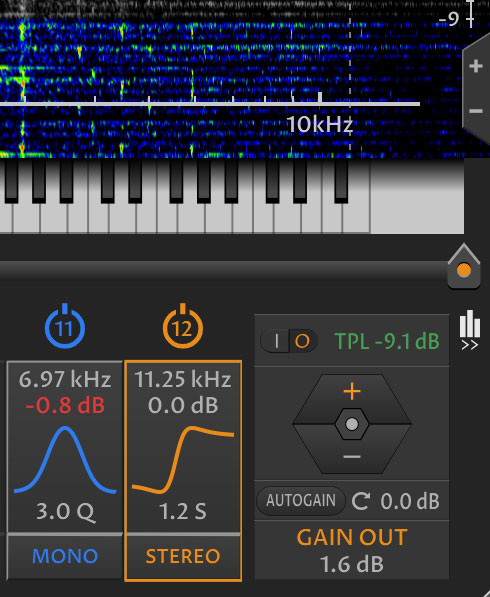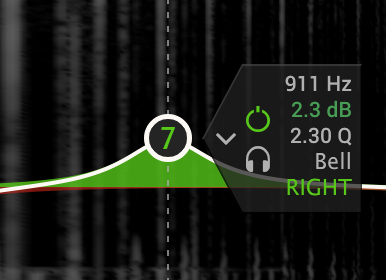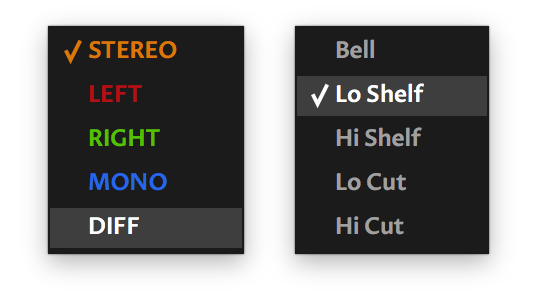Product Description
thEQred
Frequency–domain linear phase as only MAAT can make it.
• thEQred Perpetual License: $489
• thEQlp Linear Phase Subscription: $119 Annual Renewal
[thEQred + thEQorange: $9.92 per month billed annually]
• All EQ Big Bundle: $1099, $557 Total Savings
[25% Off thEQblue12, thEQred, thEQorange + free SantaCruzEQ12]

Red Is The New Black
Think of thEQred as LP PEQ Red 2.0…we’ve taken the fundamentals of Algorithmix’s exemplary LinearPhase PEQ Red, and given it a MAAT makeover. There is no other æsthetic equalizer like thEQred. With its ability to invisibly provide spectral counterweight to mixes that lean one way or another, thEQred excels at straightening up biased content. Add crystalline air without stridency to a dark mix, or beef up lower mids and bass without bloat or loss of focus. With twelve bands or Sections of precision, linear phase parametric equalization featuring unique shelving filters, mastery of complex mixes without changing their overall sonic character is just a few clicks away.
A little backstory…An idea was born to reissue this masterpiece, along with the other legendary Algorithmix EQs, and make it available as 64 bit in all common formats and (finally!) for macOS. As a power user, our visionary Friedemann had some ideas in mind regarding the improvements. Specifically, he wanted to make the user interface, the UI, more flexible and faster to use because there is no other tool in the mastering chain that receives as much “seat time.” The result: Our thEQ UI and feature set. The UI affords super fast setup and includes a number of unique features which help to speed your work: The positive & negative Contribution function including absolute difference, the highly adjustable sonogram which makes detecting problem spots easy, and the possibility to play a note on the keyboard that you have in your head and then snap a Section to that respective frequency with one click. Also, having all twelve Sections visible simultaneously, not to mention the SORT button function.
Frequency Forward
thEQred works in the frequency domain. That is, the input signal is first transformed into a spectral representation. Then, that spectral equivalent is operated upon. Special measures have been taken to ensure high resolution at critical low frequencies while keeping temporal resolution untouched. Unlike common frequency-domain filters, our linear phase approach avoids drums or other instrument containing strong transients from being blurred. In addition, extremely high compute resolution has been used to avoid any cumulative truncation effects typical in complex frequency transforms. This results in unblemished sound quality.
There are other plug–ins on the market using frequency–domain techniques. Most of them apply relatively low frequency resolution and then claim that frequency response mathematically interpolated between a few set points or that freehand drawing is the best solution. This may be true for some industrial applications, but such filters simply don’t sound musical. We’ve worked hard to insure that filter shapes in thEQred exactly match the best analog references. The result is sonic quality that is undisputed, even at baseband 44.1 and 48 kHz rates.
Unobtrusive Power
“An equalizer should have no, ideally, should have no distortion of its own. It’s almost impossible to do it without some distortion but, that’s the aim. So, if you can do that…Now there are a lot of equalizers about, where people have just taken a circuit out of some reference book and hoped for the best and they’ve never really succeeded because they haven’t taken into account all these other things.” — Rupert Neve on EQ in Rupert Neve: The SOS Interview on YouTube
thEQred was designed to deliver the highest possible linearity down to subsonic frequencies. This and other powerful features hide behind its clean and simple UI. Eye candy is great for newbies, but thEQr isn’t your typical filter: thEQred packs all the advanced features you need into one resizable window that’s easy on the eyes. Not only does the UI “get out of the way” so you can be more productive, we’ve incorporated industry–first features that speed your workflow, neatly packaged to make thEQred easy and intuitive to use.


Better By Design
Whether you’re looking for gentle rehabilitation, colorless correction, or simply baggage–free spectral contouring, our proprietary, precision algorithm delivers on the promise of linear phase EQ. Bring the power and purity of thEQred to bear for all your critical equalization tasks.
Linear Phase Royalty
Most all parametric equalizers or PEQs are implemented via phase shift. That is, the incoming dry signal is mixed with a phase–shifted version. Because the amount of the phase shift is frequency dependent, some cancellation or reinforcement occurs at the desired frequency. It gets the job done, but with a major disadvantage: the different signal components of the resulting audio become spread out in time, so time relationships between harmonics in the filtered output is heavily altered. The result: a nice sharp attack becomes slurred and muddy or worse, strident and brittle.
thEQred changes all that, providing profoundly punchy lows and airy, silky smooth highs like no other. It preserves the time relationships of harmonics, which translates into a smoother top end, sweeter and bigger midrange, and a clearer, more distinct bottom when compared to phase shift–style EQs. The resultant sound seems less processed, more like what should have naturally been captured by the microphone. You won’t get those punchy transients and silky highs with analog outboard or any ol’ IIR digital.
Versatile VariSlope
In addition to all the user–centric features that MAAT brings you, like Panorama mode and Contribution controls, thEQred features VariSlope™ technology, proprietary to thEQr. With VariSlope, shelving and cut filters offer continuous adjustment of any slope in the range from near 0 to 24 dB/octave. Unlike other EQs that let you define or draw the curve, VariSlope offers unique versatility while preserving the sound quality MAAT EQs are known for.
The exclusive VariSlope filter technology lets you dial in continuous slope filters that emulate any critically damped shelf in the range from 1st to 4th order, including all imaginary filters in between. “Imaginary” because critically damped filters offer only slopes in discreet 6 dB/octave steps per “order”: 6, 12, 18, 24 et cetera. Our continuous slope low and high cut filter performs similarly, yet you can continuously change its slope from a critically damped 4th order equivalent, through 3rd, 2nd, and 1st order down to zero. The critically damped VariSlope high cut mirrors the continuous slope VariSlope low cut.
Such “in–between” frequency-response filter characteristics, especially with slopes less than 6 dB/octave, are absolutely impossible to implement with classical filter technology. The only workaround would be to cascade many 1st order filters with specially weighted amplitudes to get the overall amplitude envelope lower then 6 dB/octave. Such kludgy filters, however, deliver a wavy frequency response characteristic and are tainted with nasty phase shift and group delay. Quite the opposite, our VariSlope filter affords very smooth, controlled spectral changes without any phase shift.
thEQred works strictly in the frequency domain, while sounding a bit softer than her linear phase sister, thEQorange. Performing at up to 384 kHz, which extends resonant frequency settings up to 80 kHz, it’s perfect for high resolution DSD, DXD and game audio post–production. Its calculations are stored at 80 bits of precision, way more than 32 bit commodity EQs and more than what even fancy 64 bit EQs manage. The result: the construction of your composite filter is impeccable, with vanishingly low THD and without loss of very low amplitude detail.
Vive La Différence
What are the differences between thEQorange and thEQred? We recommend thEQo for “surgical” work, mostly negative gain EQs to address issues in a mix during mastering when material needs to be “fixed” because it has a problem. On the other hand, thEQred is best at aesthetic work, artistic equalization that makes material sound better without affecting the time domain. As with thEQorange and both being linear phase, thEQred doesn’t leave a signature on the sound the way thEQblue does. Because it’s minimum phase not linear phase, thEQblue is for when you would reach for an analog EQ, but with ultimate fidelity that can’t be achieved with analog. So, the three of them together replace all EQ use cases, unless you want distortion, and thEQblue with its 12 Architectures replaces all analog EQs one might want.
thEQred also has VariSlope, something we think is unique in the industry. So, in keeping with that aesthetically minded approach, with thEQred, you can do really broad or really gentle lifts or suppression, as well as all the “normal” stuff you’d expect from a fixed–order EQ. Most engineers think that all equalizers are both problem solvers and artistic. To that we say, “When all you have is a hammer, everything looks like a nail.” Grab a copy of both thEQred and thEQorange, then listen to both side by side. I think you’ll hear why we think of them differently.
If you can afford only one of our thEQ products, it’s probably best to go with thEQblue. Its versatility is unsurpassed. If, however, you work with a fair amount of acoustically recorded performances and higher fidelity recordings, then over time you will find both thEQorange and thEQred indispensable. Specifically for that, we have the annual thEQlp (Linear Phase) subscription, which includes both thEQorange and thEQred.
Asymmetry Banished
Experts say that most digital EQs don’t sound like their analog antecedents, especially when working with baseband 44.1 or 48k sample rates. Spectrum modifications of high frequencies sound unbalanced. The reason is so–called “frequency warping,” which makes bell shapes asymmetric, while high shelves and cuts exhibit steeper slopes than expected. In thEQred, special corrections have been applied, making them look exactly like their analog counterparts while yielding a smooth analog sound.
If One is Good, Isn’t Two Better?
People have asked us why we haven’t included alternative modes like minimal phase and all the other options you find in competing products. Our goal as plug-in designers is to create tools from the user perspective, offering just enough flexibility with a carefully chosen set of options so the user can focus on the job at hand. It would be easy to add dozens of additional options to the preferences window but why? That’s what thEQblue is for, a whole box of “colors”! As a mastering engineer, you need specialized tools which do a particular job in the fastest and best possible manner.
thEQred is a perfect example of just such a tool. Dr.s Musialik and Hatje have already worked through an extensive refinement process. When asked about this, Musialik stated that “…the optimization and refinement of our algorithms was a very long, tedious and iterative procedure between research, development and feedback from experienced mastering engineers. Unfortunately, in high res audio, not everything is measurable or provable by numbers. This is especially true for the measurement of dynamic behavior and reactions to real–world, complex signals.”
Musialik emphasizes that “There is no ‘best’ audio tool for everybody.” His advice: Perform your own listening tests, then select which instruments you want to include in your kit.
Learn More
In this video, Friedemann discusses the differences between our three mastering equalizers
Watch it directly on YouTube
thEQred 線性相位均衡器
適合任何藝術任務
直接在 YouTube 上觀看。
thEQred Use Case
This article by John E. Johnson, Jr. discusses thEQred being used in home hi–fi setups.
Download — thEQred User Manual
The user manual PDF includes lots of useful info, check it out…
View Installation Instructions
































































































